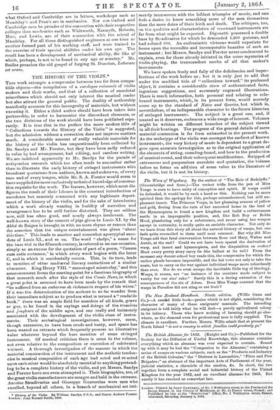THE HISTORY OF THE VIOLIN.*
History of the Violin. By William Sandys, F.S.A., and Simon Andrew Forster. London: John Russell Smith, 1864.
mately interwoven with the loftiest triumphs of music, and one feels a desire to know something more of the men themselves than the mere dates of their birth and death. The critiques, too, on the qualities and characteristics of renowned instruments are far from what might be expected. Digonetti possessed a double bass by Stradivarius for which he demanded 1,000 guineas, and had refused 800. An enthusiastic virtuoso would expatiate for hours upon the recondite and incomparable beauties of such an instrument ; but Messrs. Sandys and Forster never condescend to explain, even for those already initiated in the outer mysteries of violin-playing, the transcendent merits of all that maker's instruments.
We have spoken freely and fully of the deficiencies and imper- fections of the work before us ; but it is only just- to add that under the modified title of " collections toward," its professed object, it contains a considerable store of authenticated facts, ingenious suggestions, and accurately engraved illustrations. There is much information, both personal and relating to cele- brated instruments, which, in its present form, would scarcely come up to the standard of Notes and Queries, but which is, nevertheless, of an indispensable character to the future historian of stringed instruments. The subject is a great one, ancl, if treated as it deserves, embraces a wide range of interest. Volumes might be written on different branches of the subject viewed in all their bearings. The progress of the general details of mere material connection is far from exhausted in the present work. As the archetype of the violin was amongst the earliest of known instruments, the very history of music is dependent to a great de- gree upon accurate investigation as to the original application of the elements of string, sounding-board, and bow to the production of musical sound, and their subsequent modifications. Stripped of extraneous and purposeless anecdote and quotation, the volume before us forms an addition of some value to the literature of the violin, but it is not its history.
















































 Previous page
Previous page